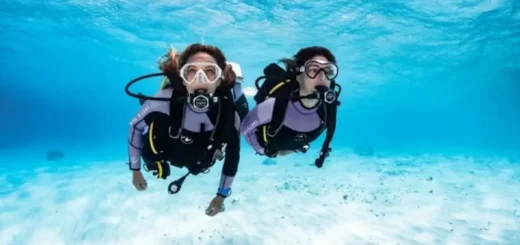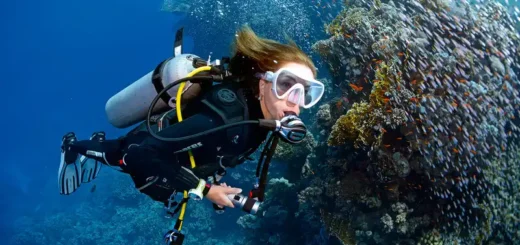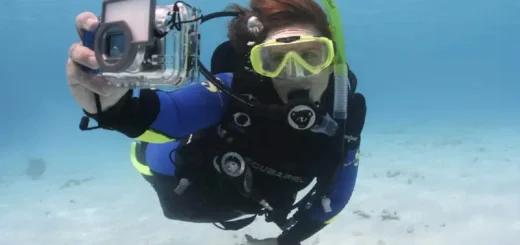Scuba Diving in New Zealand
Scuba diving in New Zealand offers a unique and exciting experience for both locals and visitors. With its clear waters, diverse marine life, and varied diving locations, New Zealand is a premier destination for scuba diving enthusiasts. Whether you’re a seasoned diver or just starting out, there’s something for everyone to explore and enjoy.
Learn to Scuba Dive
To start diving, it’s important to take a scuba diving course from a certified instructor. There are several different types of scuba diving courses available, each designed to meet the needs of different levels of divers. The most basic level of scuba diving course is the Open Water Diver course, which provides the basic knowledge and skills needed to safely scuba dive. After Open Water Diver, there are a variety of other courses that you can take to continue your diving education such as Advanced Open Water Diver, Rescue Diver, Divemaster and Instructor.
Learning to scuba dive is a fun and exciting process that can open up a whole new world of adventure and exploration. To get started, you will need to take a scuba diving course from a certified instructor. There are several different types of scuba diving courses available, each designed to meet the needs of different levels of divers.
The most basic level of scuba diving course is the Open Water Diver course. This is typically the first course that most people take and it provides the basic knowledge and skills needed to safely scuba dive. The course typically includes classroom sessions, pool training, and open water dives. Upon completion of the course, you will be certified as an Open Water Diver.
After Open Water Diver, there are a variety of other courses that you can take to continue your diving education such as Advanced Open Water Diver, Rescue Diver, Divemaster and Instructor. These courses will provide more in-depth training and allow you to dive deeper, in more challenging environments, and also teach you how to assist and lead other divers.
The best way to find a scuba diving course is to look for a PADI (Professional Association of Diving Instructors) or SSI (Scuba Schools International) Dive Center or Instructor near your location. These are the two most recognized diving certification organizations in the world. The Dive Center or Instructor will be able to provide you with information about the different courses they offer, the schedule and the cost.
Overall, learning to scuba dive is a fun and exciting process that will open up a whole new world of adventure and exploration. With the right training and equipment, you’ll be able to safely explore the underwater world and discover the many wonders it has to offer.
Scuba Diving Course
One of the best ways to find a scuba diving course is to look for a PADI (Professional Association of Diving Instructors) or SSI (Scuba Schools International) Dive Center or Instructor near your location. These are the two most recognized diving certification organizations in the world. The Dive Center or Instructor will be able to provide you with information about the different courses they offer, the schedule, and the cost.
A scuba diving course is a program that provides training and education to individuals who wish to learn how to scuba dive. The course is designed to teach the basic knowledge and skills needed to safely scuba dive, and is typically taught by a certified instructor.
There are several different types of scuba diving courses available, each designed to meet the needs of different levels of divers. The most basic level of scuba diving course is the Open Water Diver course, which provides the basic knowledge and skills needed to safely scuba dive. This course typically includes classroom sessions, pool training, and open water dives. Upon completion of the course, the student will be certified as an Open Water Diver.
Other types of scuba diving courses include:
- Advanced Open Water Diver: This course is designed for divers who have completed the Open Water Diver course and want to continue their education. The course includes additional training in diving techniques, such as deep diving and navigation.
- Rescue Diver: This course is designed to teach divers how to handle emergency situations and how to assist other divers in distress.
- Divemaster: This is the first professional level of diving, Divemaster is responsible for assisting the instructor and leading dives.
- Instructor: This is the highest level of diving education, an instructor is able to certify divers.
The best way to find a scuba diving course is to look for a PADI (Professional Association of Diving Instructors) or SSI (Scuba Schools International) Dive Center or Instructor near your location. These are the two most recognized diving certification organizations in the world. The Dive Center or Instructor will be able to provide you with information about the different courses they offer, the schedule, and the cost.
Special equipment needed for scuba diving
There are several pieces of equipment that are essential for scuba diving, these include:
- Dive Mask: A dive mask allows divers to see underwater by creating an air space in front of the eyes, which compensates for the difference in water and air pressure.
- Regulator: This is the device that allows divers to breathe underwater. It attaches to the scuba tank and reduces the high-pressure air to a breathable level.
- Buoyancy Control Device (BCD): A BCD is a vest-like device that helps divers control their buoyancy underwater. This allows divers to stay at a specific depth or hover in the water.
- Fins: Fins provide propulsion underwater, allowing divers to swim more efficiently.
- Wetsuit or Drysuit: A wetsuit or drysuit helps to protect divers from the cold water and maintain body heat.
- Dive Computer: A dive computer is an electronic device that keeps track of the diver’s depth, dive time, and remaining air supply.
- Dive Tank: A dive tank is a cylinder that contains compressed air, which is used by the diver to breathe underwater.
Other equipment that is often used but not necessarily required includes dive lights, dive knives, and underwater cameras. It’s also important to note that some specific types of diving, like Technical Diving, Cave Diving, or Rebreather diving may require additional specific gear.
Deep Diving
Deep diving is also an option for more experienced divers, it is diving to depths greater than 18 meters (60 feet) and it requires advanced training, experience and specialized equipment. This type of diving is considered to be more challenging than shallow diving because of the increased water pressure, which affects the body in various ways. At deeper depths, the diver is also exposed to colder water temperatures, reduced visibility, and stronger currents.
Deep scuba diving is the practice of diving to depths greater than 18 meters (60 feet). This type of diving requires advanced training, experience, and specialized equipment, as the risks and hazards of deep diving are different than those of shallower dives.
Deep diving is considered to be more challenging than shallow diving because of the increased water pressure, which affects the body in various ways. At deeper depths, the diver is also exposed to colder water temperatures, reduced visibility, and stronger currents. These factors can affect the diver’s buoyancy, air consumption, and overall safety.
To safely deep dive, a diver must have completed an advanced level of training and hold a certification that specifically covers deep diving. This type of certification will provide the diver with the knowledge and skills to safely plan and execute deep dives, including the use of specialized equipment such as dive computers, and specialized diving techniques for deep diving.
Additionally, deep diving requires specialized equipment such as a dive computer and a dive watch, that allows the diver to monitor his/her dive profile, including the dive time, depth, and remaining air supply, it’s also important to use a dive cylinder with a larger capacity of air to allow for longer bottom times.
Deep diving is a challenging and demanding activity that is not suitable for all divers. It requires a high level of physical fitness, a good understanding of diving physics, and a high level of experience. Deep diving should only be attempted by divers who are properly trained, certified, and experienced in deep diving techniques and procedures.
Best Place to Scuba Dive In New Zealand
New Zealand offers a wide range of diving locations, from sheltered bays and harbors to rugged coastline and offshore islands. Some of the best diving locations in New Zealand include:
- Poor Knights Islands: Located off the northeastern coast of the North Island, the Poor Knights Islands offer some of the best diving in New Zealand. The islands are home to a rich variety of marine life, including colorful fish, sea turtles, and even sharks. The clear waters and rugged coastline make for a unique and exciting diving experience.
- The Great Barrier Reef: The Great Barrier Reef is a popular diving destination located off the northeastern coast of the North Island. The reef is home to a diverse array of marine life, including colorful fish, sea turtles, and even sharks. The best time to visit the Great Barrier Reef for diving is during the summer months, between December and April, when the water is warmest and visibility is at its best.
- The Marlborough Sounds: The Marlborough Sounds are a network of sheltered bays and inlets located at the top of the South Island. The area is known for its clear waters and diverse marine life, including fish, dolphins, and seals. The Marlborough Sounds also offer the opportunity to explore shipwrecks and other underwater structures.
- Stewart Island: Located off the southern coast of the South Island, Stewart Island offers a unique diving experience. The island is home to a wide variety of marine life, including colorful fish, penguins, and seals. The area is also known for its clear waters, rugged coastline, and remote location, making for a truly wild and remote diving experience.
- Fiordland: The Fiordland National Park is located in the southwestern corner of the South Island and offers a rugged and remote diving experience. The area is home to a wide variety of marine life, including fish, dolphins, and seals. The fiords also offer the opportunity to explore underwater caves, shipwrecks and other submerged structures.
These are just a few examples of the many great diving locations that New Zealand has to offer, there are many other great diving spots around the country that offer different experiences and type of diving, from sheltered bays to shipwrecks, from caves to open ocean, from temperate water to cold water diving.
Scuba Diving in New Zealand
New Zealand offers a wide range of diving locations, from sheltered bays and harbors to rugged coastline and offshore islands. Some of the best diving locations in New Zealand include: Poor Knights Islands, The Great Barrier Reef, The Marlborough Sounds, Stewart Island and Fiordland National Park. These locations offer a diverse range of diving experiences, from rich marine life to shipwrecks and underwater caves.
Overall, scuba diving in New Zealand offers a unique and exciting experience that allows divers to explore the diverse marine life and discover the many wonders of the underwater world. With the right training, education, and equipment, scuba diving can be a safe and enjoyable activity for all levels of divers. New Zealand is a must-visit destination for all diving enthusiasts.







